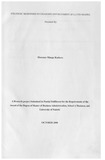| dc.description.abstract | External pressures resulting from public opinion, regulations, the green movement and financial enterprises, and internal drivers related to a change in employees’ awareness, have led companies to consider the environment in strategic management (Muturi, 2003). Academics and practitioners have attempted to improve understanding of firms' environmental strategies by characterizing their environmental actions. The major interest of the past studies was how to describe and predict a trend and change in corporate environmental management and strategy.
Environment has been characterized as complex, dynamic, multi-facet and having far reaching impact (Kazmi 2002). As a result, of these characteristics, the environment is composed of various factors, events, conditions and influence which interact with each other to create an entirely new set of influences leading to constant environmental change in its shape and character. A fundamental change is occurring in the world economy whereby the world economies are witnessing the forces of globalization and liberalization of trade. The phenomenon of globalization, according to Muturi (2003) refers to “the fact that people around the world are becoming more and more knowledgeable about each other,” this is expected to increasingly affect the real estate sector
This study is a case study; it seeks to achieve the objectives of the study, which were to establish the strategic response to external environment of Lloyd Masika. The importance of a case study is emphasized by Young (1960) who acknowledged that a case study is a powerful form of qualitative analysis that involves a careful and complete observation of a social unit, irrespective of what type of unit is under study. It’s a method that drills down, rather than cast wide.
The study will mainly use primary data which will be collected through an interview. The data collection instrument will be an interview guide a copy of which is attached in Appendix I. Four respondents will be interviewed. These will be the managing Director and the three Departmental Directors (valuation, management and letting and sales departments). The reason for choosing this methodology will be that it does not restrict respondents on answers and has potential of generating more information with much detail. The qualitative method is used to uncover and understand what lies behind a phenomenon under study.
External pressures resulting from public opinion, regulations, the green movement and financial enterprises, and internal drivers related to a change in employees’ awareness, have led companies to consider the environment in strategic management (Muturi, 2003). Academics and practitioners have attempted to improve understanding of firms' environmental strategies by characterizing their environmental actions. The major interest of the past studies was how to describe and predict a trend and change in corporate environmental management and strategy.
Environment has been characterized as complex, dynamic, multi-facet and having far reaching impact (Kazmi 2002). As a result, of these characteristics, the environment is composed of various factors, events, conditions and influence which interact with each other to create an entirely new set of influences leading to constant environmental change in its shape and character. A fundamental change is occurring in the world economy whereby the world economies are witnessing the forces of globalization and liberalization of trade. The phenomenon of globalization, according to Muturi (2003) refers to “the fact that people around the world are becoming more and more knowledgeable about each other,” this is expected to increasingly affect the real estate sector
This study is a case study; it seeks to achieve the objectives of the study, which were to establish the strategic response to external environment of Lloyd Masika. The importance of a case study is emphasized by Young (1960) who acknowledged that a case study is a powerful form of qualitative analysis that involves a careful and complete observation of a social unit, irrespective of what type of unit is under study. It’s a method that drills down, rather than cast wide.
The study will mainly use primary data which will be collected through an interview. The data collection instrument will be an interview guide a copy of which is attached in Appendix I. Four respondents will be interviewed. These will be the managing Director and the three Departmental Directors (valuation, management and letting and sales departments). The reason for choosing this methodology will be that it does not restrict respondents on answers and has potential of generating more information with much detail. The qualitative method is used to uncover and understand what lies behind a phenomenon under study. | en |

